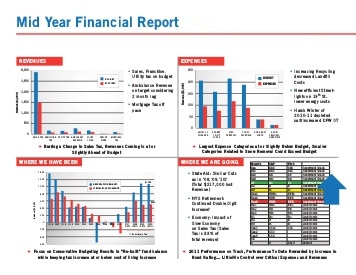
Many companies track financial data weekly, monthly, and quarterly, which is a good idea. But time gets away, and it seems like all of a sudden, the year is half over. In today’s business environment, changes happen rapidly in industries and companies. Mid-year is a good time to do a check-up on company progress year-to-date and also evaluate key performance indicators (KPIs). There’s still time to make corrections to be sure 2016 ends on a high note.
Managing by Milestones
A milestone, in project management terms, is simply a point along a project timeline. Milestones are set so project managers recognize when that portion of the project has been completed. They can also be helpful for tracking financial goals as well.
Compare year to date progress with prior years to determine if seasonality is consistent with prior years’ seasonality. If the amount falls short, recognize that and perhaps add some incentives or promotions to spike revenues and correct the shortfall before the year ends. It’s also important to try and understand the reason for the revenue decline. If the company is ahead of projections, determine what is working well and make sure to replicate it.
Be sure to update forecasts for the rest on the year and see if any tweaks are needed to hit 2016 goals. Observing milestones makes companies proactive in reaching or surpassing goals.
By the Numbers
We encourage all of our clients to generate meaningful KPIs for the company/industry business model and then set up a schedule for reviewing, evaluating, and updating them. Some are daily, weekly, monthly, or any other relevant frequency. KPIs may be the same or in addition to other milestones that are helpful for tracking company health.
Some of KPI’s we have created for clients include:
- YTD Revenue vs. Prior YTD Revenue – Gross revenues are a great topline measurement tool.
- Change in debt YoY – Debt has a significant impact on cash flow and company health.
- Break-even analysis – Is old run-down equipment costing us more in repairs or are we outsourcing things we should bring in house (rental equipment, consulting, trucking)?
- Revenue per employee/sales person/crew, etc. – How efficiently are we generating revenue? Do additional employees generate revenue or just add to overhead?
- Number of clients added or lost or both – Is the company growing with referrals, or churning business?
- Days to break-even – How many days were required just to cover the overhead?
- Fixed cash burn – helps determine the minimum cash flow required just to keep the doors open.
Project Performance
Milestones don’t have to be numeric. It’s helpful to determine if internal projects are on track. Perhaps for 2016, the goal was to replace 5 PCs and convert online shopping cart software. Set milestones to monitor specific phases of these projects or just monitor start and completion dates.
Staffing Allocation
Take a look at staffing. Often the best way to do this is to map out what the company structure will look like in 3 years. Then determine if the current staff will be able to fill those roles and what is required to get there. For example, are employees in the best positions to be productive? Do any employees merit a promotion or should they be replaced? Consider expanding or re-assigning duties as the business requires. Also consider client needs to determine if additional hires will benefit the company in the short and/or long term.
Mid-Year Milestone Report
Document accomplishments in a mid-year milestones report. It feels good to write them down, plus there’s documentation for accomplishments, what’s working and what’s not working as well as it should.
The report can include the milestones as well as a narrative explaining the performance to date.
Accounting for milestones helps companies become more proactive toward reaching business goals. Plus, it’s great to see progress since the beginning of the year and/or year-over-year.

Should I Use The Same Company for CFO and Bookkeeping Services or Keep Them Separate?
by Lucrum Staff Is your company considering outsourcing fractional CFO and bookkeeping services to two different companies? Using a single provider for …

Do I Need a Fractional CFO, Interim CFO or Part-Time CFO? What’s the Difference?
by: Lucrum Staff As a business scales, it reaches a point where more financial expertise is needed than existing resources can provide. …

When To Politely Turn Down A New Business Opportunity
By: Jeff Heybruck New business opportunities are, for good reason, exciting. But wise business leaders are able to take off the rose-colored …
